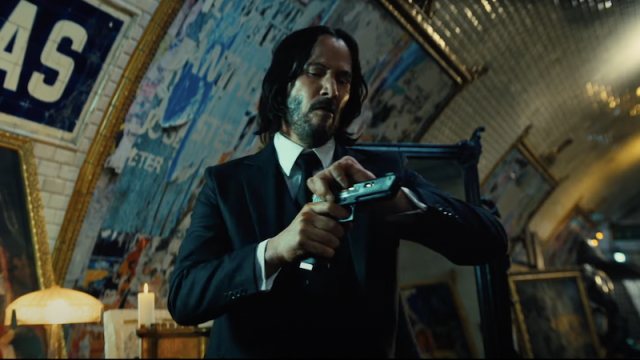The first time we hear Keanu Reeves speak in John Wick Chapter 4, it’s to say a single word: “Yeah.” It may not seem like much, but over the course of four movies, Reeves-as-Wick has come to own that word, finding countless variations in his delivery that can render it hilarious, tense, and heartbreaking, sometimes all at once. His trick is similar to what the series as a whole has been able to pull off, reivingorating the moribund action genre from its ate-00s/mid-10s doldrums by continually finding clever twists on a formula.
Chapter 4 picks up where the previous film left off, with Wick making alliances with the Bowery King (Laurence Fishburne) to take down the High Table— a shadowy council of gang leaders who (the series implies) essentially run the world — after one of his few remaining friends, Continental Hotel manager Winston (the great Ian McShane) betrays him. The High Table, hoping to end the conflict as quickly as possible, has granted the Marquis de Gramont (Bill Skarsgård, at his oiliest) unlimited means to dispose of him. The Marquis extorts Wick’s old friend Caine (Donnie Yen, excellent) into tracking John down and killing him. Meanwhile, the mysterious Mr. Nobody (Shamier Anderson, in a star-making turn) forms an uneasy alliance with Wick in order to drive up the bounty on his head before he collects it.
There’s a lot going on here, and at two hours and forty-nine minutes, it can feel overstuffed. Chapter 4 is the first John Wick movie not written by series creator Derek Kolstad, and his imagination and deceptively simple plotting is much missed. Chapter 3 opened with an extended action scene that featured Wick dispatching henchman with books, horses, swords, and knives; Chapter 4’s focus on gunplay can’t help but feel like a step down in comparison.
Fortunately, series director Chad Stahelski is on hand and keeps the proceedingsfleet-footed. His way of shooting action scenes in fluid long takes pretty much changed the game overnight in Hollywood action cinema (you absolutely could not get away with anything like the infamous fence-jumping scene from Taken 3 today), and he keeps finding ways to top himself here, from sword and bow and arrow fights at the Osaka Continental to a top-down shootout in a Paris apartment. He openly borrows from Lawrence of Arabia, The Warriors, Sergio Leone, and Barry Lyndon in ways that feel ambitious and respectful instead of a game of “spot the reference.” With only the John Wick movies on his directing resume, he has still found a way to establish himself as one of the most thrilling contemporary action directors.
Stahelski and Reeves have implied that the mainline series might take a break after this installment, and Chapter 4 does feel like the logical endpoint of a trilogy that started with Chapter 2 (the original is so low-key and self-contained by comparison, that it feels almost completely separate from the rest of the series). If this is the last John Wick movie we get for a long time, then Stahelski and Reeves have gone out on a high point.


